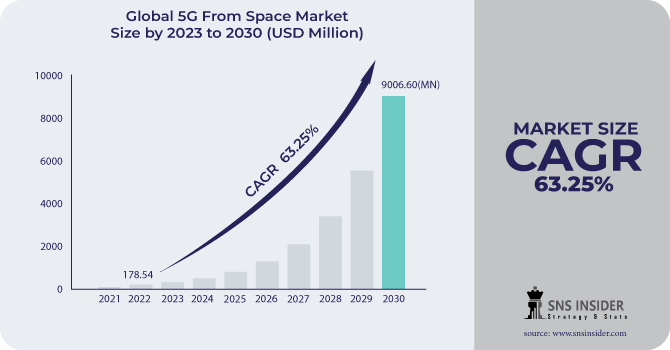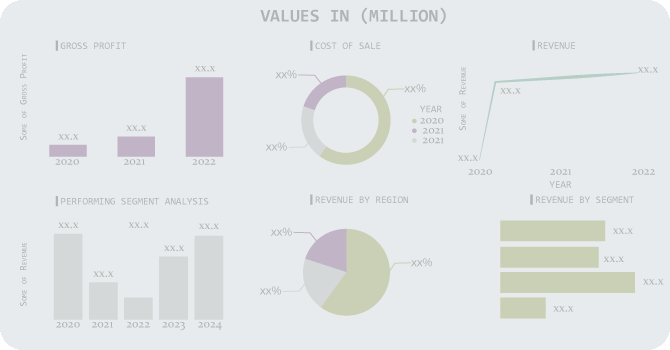5G From Space Market key Insights:
The 5G From Space Market Size was valued at USD 291.5 million in 2023, and is expected to reach USD 24003.1 million by 2032, and grow at a CAGR of 63.3% over the forecast period 2024-2032.
5G networks are critical in assisting governments and politicians in the transformation of cities into smart cities, allowing inhabitants to participate in and reap the socioeconomic benefits of a sophisticated, digital, data-intensive economy. Governments will be pushed to build and update passive assets such as fibre networks and data centres as a result. The growth of the Internet of Things (IoT) has produced a desire for improved connectivity for a wide range of devices.

To get more information on 5G From Space Market - Request Sample Report
The expansion of space-based services including satellite-based Earth observation, remote sensing, and space tourism demands a trustworthy and rapid communication infrastructure. These shifting expectations can be met by 5G from space. Because of the evolving and developing character of geopolitical conflicts and wars, integrating non-terrestrial technology into defence forces has become increasingly crucial.
Advanced 5G satellite communication technology can help defence agencies improve their strategic and decision-making capabilities. A fundamental cause pushing the growth of satellite-enabled IoT in the defence industry is the absence of network connections in distant terrains such as deserts, seas, and mountains. This integration enables the delivery of high-speed, low-latency connectivity to critical communications and applications in industries such as telecommunications and media & entertainment, cellular backhaul, retail and consumers, business and enterprise, aviation, scientific research and development, marine vessels, transportation, and logistics.
5G from space has the potential to bridge the digital gap and ensure smooth communication in even the most demanding circumstances due to its capacity to create dependable connections in regions where terrestrial infrastructure construction is unfeasible or economically unviable. Furthermore, integrating 5G from space with terrestrial networks improves communication systems' overall resiliency and redundancy, as satellite links can serve as a backup option during network outages or disasters, facilitating the rapid restoration of connectivity and enabling critical decision-making processes in communication, command, and control centres.
The development of 5G networks necessitates substantial infrastructure expenditures, such as the installation of new base stations, tiny cells, and fibre optic connections. Because of its emphasis on smaller cell sizes and improved network capacity, 5G infrastructure rollout requires a denser network design than previous generations of cellular networks. Densification raises infrastructure needs and total capital investment, resulting in high initial costs for network operators and service providers. This is projected to impede market expansion.
MARKET DYNAMICS
DRIVERS:
-
The proliferation of IoT devices requires widespread connectivity.
-
Global Connectivity is the driver of the 5G From Space Market.
5G from space can provide high-speed internet access to areas that are difficult to reach through traditional terrestrial networks. This global connectivity is essential for enabling communication, IoT (Internet of Things), and other data-driven applications in remote or rural locations.
RESTRAIN:
-
Building and maintaining a satellite network capable of providing 5G connectivity involves complex technical challenges.
-
Competition with Terrestrial Networks is the restraint of the 5G From Space Market.
Traditional terrestrial 5G networks are also advancing and expanding their coverage. Depending on the region and existing infrastructure, there might be competition between satellite-based 5G and terrestrial networks.
OPPORTUNITY:
-
Satellite-based 5G can play a vital role in disaster recovery and emergency response.
-
Entrepreneurship and Innovation is an opportunity of the 5G From Space Market.
The growth of the 5G from space market opens doors for entrepreneurs, startups, and innovators to develop new applications, services, and business models that leverage the unique capabilities of satellite-based connectivity.
CHALLENGES:
-
Designing, deploying, and maintaining a satellite network capable of providing 5G connectivity is technically complex.
-
Consumer Adoption and Perception are the challenges of the 5G From Space Market.
Convincing consumers and businesses to adopt satellite-based 5G services, especially in regions with existing reliable connectivity, can be a challenge. Perceived performance differences, cost considerations, and user equipment compatibility can impact adoption rates.
IMPACT OF RUSSIA-UKRAINE WAR
Russia's invasion of Ukraine has already had global implications, from rising oil prices to forcing hundreds of thousands of migrants to seek asylum in Europe and abroad. The problem has already damaged equipment vendors like Nokia and smartphone providers like Apple in the global telecoms business. According to a new FCC petition by satellite operator SES, the war may ultimately find its way into the heart of the US's expanding 5G deployment in the key mid-band spectrum. Thales Alenia Space depends on the Ukrainian Antonov AN-124 aircraft charter for geostationary satellite transportation, such as SES-22, to launch locations, SES told the FCC last week. However, because of Russia's military conflict in Ukraine, no Antonov planes are available to deliver SES-22 to the launch site in Cape Canaveral, Florida. ES and Intelsat met the FCC's first major deadline on the project, allowing Verizon and AT&T to begin 5G operations in the C-band spectrum early this year. However, some US aviation authorities were concerned that 5G activities in the C-band may interfere with aircraft altimeters. As a consequence, AT&T and Verizon agreed to postpone their C-band rollouts near airports until August.
Under the FCC's initial proposal to relocate their operations off of the C-band over the next two years, Intelsat and SES stand to earn a total of $5.1 billion and $4.01 billion, respectively. However, Verizon stated last month that it will pay SES an extra $170 million to free up more C-band airwaves ahead of the FCC deadlines. According to Verizon, this agreement would allow it to install up to 100 MHz of spectrum in some places before 2023, as well as offer C-band 5G services in an additional 30 markets, Washington, DC, Baltimore, including Atlanta, and Denver. according to the FCC's initial plan to transition their activities away from the C-band over the following two years. However, Verizon stated last month that it will pay SES an extra $172 million to free up more C-band airwaves ahead of the FCC deadlines.
IMPACT OF ONGOING RECESSION
Over the following year, 610 million new 5G subscribers will be established globally. Despite the numerous economic obstacles, the positive economic gain from this expansion is a $320 billion value to operators of 5G-related services by the end of 2023, or a 62% growth rate. The 5G industry would be driven by the rapid migration of cellular subscriptions to 5G networks as a result of operator plans that reduce or eliminate any premium above the present 4G subscription options. Consumer connections will continue to form the backbone of 5G operator revenue growth. In 2027, personal devices such as smartphones, tablets, and mobile broadband routers would account for more than 96% of worldwide 5G connections. Looking ahead, 5G network growth has been consistent during the research period, with 5G connections accounting for more than 82% of worldwide operator billed revenue by 2027. 5G availability was emerging as the new customer happiness standard. Geographical coverage, indoor and outdoor coverage, and congregation hotspot coverage are more essential than population coverage in developing user impressions.
KEY MARKET SEGMENTATION
By Component
-
Services
-
Hardware
By Vertical
-
Commercial
-
Government & Defense
By Application
-
Massive Machine Type Communication (mMTC)
-
Enhanced Mobile Broadband (eMBB)
-
Ultra-Reliable Low Latency Communication (URLLC)
.png)
Need any customization research on 5G From Space Market - Enquiry Now
REGIONAL COVERAGE
North America
-
US
-
Canada
-
Mexico
Europe
-
Eastern Europe
-
Poland
-
Romania
-
Hungary
-
Turkey
-
Rest of Eastern Europe
-
-
Western Europe
-
Germany
-
France
-
UK
-
Italy
-
Spain
-
Netherlands
-
Switzerland
-
Austria
-
Rest of Western Europe
-
Asia Pacific
-
China
-
India
-
Japan
-
South Korea
-
Vietnam
-
Singapore
-
Australia
-
Rest of Asia Pacific
Middle East & Africa
-
Middle East
-
UAE
-
Egypt
-
Saudi Arabia
-
Qatar
-
Rest of Middle East
-
-
Africa
-
Nigeria
-
South Africa
-
Rest of Africa
-
Latin America
-
Brazil
-
Argentina
-
Colombia
-
Rest of Latin America
REGIONAL ANALYSIS
North America: North America has been at the forefront of the Internet of Things adoption across a wide range of industries, including smart cities, healthcare, transportation, and agriculture. 5G connectivity from orbit might provide continuous data transfer and communication for a large number of Internet of Things (IoT) devices and sensors.
Asia Pacific: In the near future, Asia Pacific, 5G From the Space Market, is predicted to have the highest growing market share in terms of revenue. Governments in the Asia Pacific are aggressively investing in infrastructure development and digital projects. They recognise the need for increased connectivity and digital transformation for economic development and competitiveness. These policies establish an environment conducive to the acceptance and implementation of 5G from space technology, hence expediting its regional growth.
Key Players
The major players are SES S.A., Qualcomm, OneWeb, Ericsson, Omnispace, Rohde & Schwarz, Lynk Global, Echostar Corporation, China Aerospace Science & Technology Corporation and other players.
Qualcomm-Company Financial Analysis

RECENT DEVELOPMENTS
In 2023: Dish Network and EchoStar have chosen to collaborate in order to link people on Earth and in space. After receiving official clearance for their all-stock merger, Dish stockholders held 69% of the new company, while EchoStar owners owned the balance.
In 2022: Qualcomm Technologies, Inc. & Thales, a French aerospace corporation, planned to deploy 5G into an Earth-orbiting satellite network. Each party aimed to test and validate 5G non-terrestrial networks (5G NTN) with smartphone use cases after undertaking considerable research, including several studies and simulations.
| Report Attributes | Details |
| Market Size in 2022 | US$ 291.5 Mn |
| Market Size by 2030 | US$ 24003.1 Mn |
| CAGR | CAGR of 63.3% From 2023 to 2030 |
| Base Year | 2022 |
| Forecast Period | 2023-2030 |
| Historical Data | 2019-2021 |
| Report Scope & Coverage | Market Size, Segments Analysis, Competitive Landscape, Regional Analysis, DROC & SWOT Analysis, Forecast Outlook |
| Key Segments | • By Components (Services and Hardware) • By Vertical (Commercial, Government & Defense) • By Application (Massive Machine-Type Communications, Enhanced Mobile Broadband, Ultra-Reliable & Low Latency Communication) |
| Regional Analysis/Coverage | North America (US, Canada, Mexico), Europe (Eastern Europe [Poland, Romania, Hungary, Turkey, Rest of Eastern Europe] Western Europe] Germany, France, UK, Italy, Spain, Netherlands, Switzerland, Austria, Rest of Western Europe]), Asia Pacific (China, India, Japan, South Korea, Vietnam, Singapore, Australia, Rest of Asia Pacific), Middle East & Africa (Middle East [UAE, Egypt, Saudi Arabia, Qatar, Rest of Middle East], Africa [Nigeria, South Africa, Rest of Africa], Latin America (Brazil, Argentina, Colombia Rest of Latin America) |
| Company Profiles | SES S.A., Qualcomm, OneWeb, Ericsson, Omnispace, Rohde & Schwarz, Lynk Global, Echostar Corporation, China Aerospace Science & Technology Corporation |
| Key Drivers | • The proliferation of IoT devices requires widespread connectivity. • Global Connectivity is the driver of the 5G From Space Market |
| Market Restraints | • Building and maintaining a satellite network capable of providing 5G connectivity involves complex technical challenges. • Competition with Terrestrial Networks is the restraint of the 5G From Space Market. |

